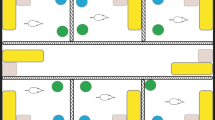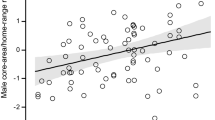Abstract
We compared seasonal shelter selection and social behavior of Mesobuthus gibbosus from autumn to mid-summer in two similar phryganic ecosystems, in continental Greece (near Volos city) and in insular Greece (eastern Crete), and in the laboratory under simulated abiotic conditions. Our results showed that shelter selection is a critical indicator of the seasonal social behavior of the species. The abrupt climatic changes in spring caused a differentiation in shelter selection between the cold period (November–February) and the warm period (March–June) at both sites. Sociality was exhibited only during winter in the field and was more extensive under cold conditions in the laboratory. Co-occurrence of scorpions proved to be age-specific, facilitated by population density and by harsh abiotic conditions during winter, and negatively influenced by intraspecific competition, which was higher in continental Greece. The response of scorpions to changes of abiotic factors reveals synchronization of seasonal shelter selection with climatic changes.


Similar content being viewed by others
References
Avilés L (1997) Causes and consequences of cooperation and permanent sociality in spiders. In: Choe JC, Crespi BJ (eds) The evolution of social behavior in insects and arachnids. Cambridge University Press, Cambridge, pp 476–498
Brownell PH (2001) Sensory ecology and orientational behaviors. In: Brownell PH, Polis GA (eds) Scorpion biology and research. Oxford University Press, Oxford, pp 159–183
Cooper SM, Ginnett TF (1998) Spines protect plants against browsing by small climbing mammals. Oecologia 113:219–221
Crucitti P, Marini F (1987) Ecology of Mesobuthus gibbosus (Brullé, 1832) in the Pindus Mountains (Epirus and Thessaly, Greece) (Scorpiones, Buthidae). G Ital Entomol 16(3):291–303
Eastwood EB (1978) Notes on the scorpion fauna of Cape. III, some observations on the distribution and biology of scorpions on Table Mountain. Ann S Afr Mus 74:229–248
Hölldobler B, Wilson EO (1990) The ants. Springer, Berlin
Hulbert SH (1984) Pseudoreplication and the design of ecological field experiments. Ecol Monogr 54(2):187–211
Kaltsas D, Stathi I, Mylonas M (2006) The effect of insularity on the seasonal population structure of Mesobuthus gibbosus (Scorpiones: Buthidae). Euscorpius 44:1–8
Kaltsas D, Stathi I, Mylonas M (2008) The foraging activity of Mesobuthus gibbosus (Scorpiones: Buthidae) in central and south Aegean archipelago. J Nat Hist 42:513–527
Kuhar CW (2006) In the deep end: pooling data and other statistical challenges of zoo and aquarium research. Zoo Biol 25:339–352
Linsenmair KE (1984) Comparative studies on the social behaviour of the desert isopod Hemilepistus reaumuri and of a Porcellio species. Symp Zool Soc Lond 53:423–453
MacArthur RH, Diamond JM, Karr JR (1972) Density compensation in island faunas. Ecology 53(2):330–342
Machlis L, Dodd PWD, Fentress JC (1985) The pooling fallacy: problems arising when individuals contribute more than one observation to the data set. Z Tierpsychol 68:201–214
Mahsberg D (1990) Brood care and family cohesion in the tropical scorpion Pandinus imperator (Koch) (Scorpiones: Scorpionidae). Acta Zool Fennica 190:267–272
Mahsberg D (2001) Brood care and social behaviour. In: Brownell PH, Polis GA (eds) Scorpion biology and research. Oxford University Press, Oxford, pp 257–277
Maury EA (1973) Los escorpiones de los sistemas serranos de la provincia de Buenos Aires. Physis (Buenos Aires) 32(85):351–371
McAlister WH (1966) The aggregating tendency of Centruroides vittatus Say (Arachnida: Scorpionida). Texas J Sci 18:80–84
Polis GA (1980) Seasonal patterns and age-specific variation in the surface activity of a population of desert scorpions in relation to environmental factors. J Anim Ecol 49:1–18
Polis GA (1984) Age structure component of niche width and intraspecific resource partitioning: can age groups function as ecological species? Am Nat 123(4):541–564
Polis GA (1990) Ecology. In: Polis GA (ed) The biology of scorpions. Stanford University Press, Stanford, pp 247–293
Polis GA, Lourenço WR (1986) Sociality among scorpions. Actas Cong Int Aracnol Jaca/España I:111–115
Polis GA, McCormick SJ (1986) Patterns of resource use and age structure among species of desert scorpions. J Anim Ecol 55:59–73
Polis GA, McCormick SJ (1987) Intraguild predation and competition among desert scorpions. Ecology 68(2):332–343
Polis GA, Myers C, Quinlan M (1986) Burrowing biology and spatial distribution of desert scorpions. J Arid Environ 10:137–146
Shachak M, Brand S (1983) The relationship between sit and wait foraging strategy and dispersal in the desert scorpion, Scorpio maurus palmatus. Oecologia 60:371–377
Sherman P, Jarvis J, Alexander R (1991) The biology of the naked molerat. Princeton University Press, Princeton
Stahnke HL (1966) Some aspects of scorpion behavior. Bull South Calif Acad Sci 65:65–80
Warburg MR (2000) Intra- and interspecific cohabitation of scorpions in the field and the effect of density, food, and shelter on their interactions. J Ethol 18:59–63
Warburg MR, Polis GA (1990) Behavioral responses, rhythms, and activity patterns. In: Polis GA (ed) The biology of scorpions. Stanford University Press, Stanford, pp 224–246
Wilson EO (1975) Sociobiology: the new synthesis. Harvard University Press, Cambridge
Zinner H, Amitai P (1969) Observations on hibernation of Compsobuthus acutecarinatus E. Sim. and C. schmiedeknichti Vachon (Scorpionidea, Arachnida) in Israel. Isr J Zool 18:41–47
Acknowledgments
We thank Dr Maria Chatzaki, Giannis Anastasiou, Aria Daskalaki, and Thomas Kaltsas for their constitutive communication, support, and encouragement.
Author information
Authors and Affiliations
Corresponding author
About this article
Cite this article
Kaltsas, D., Stathi, I. & Mylonas, M. Intraspecific differentiation of social behavior and shelter selection in Mesobuthus gibbosus (Brullé, 1832) (Scorpiones: Buthidae). J Ethol 27, 467–473 (2009). https://doi.org/10.1007/s10164-008-0144-6
Received:
Accepted:
Published:
Issue Date:
DOI: https://doi.org/10.1007/s10164-008-0144-6




